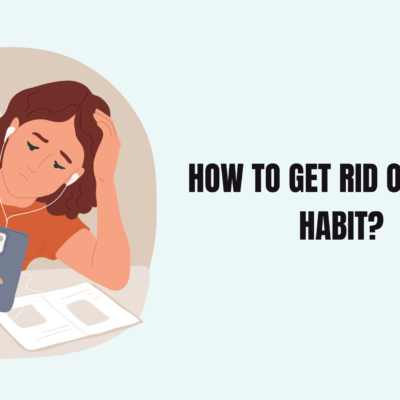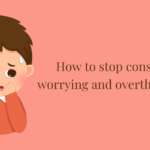How to Get Rid of a Bad Habit: Bad habits are a part of life. Whether it’s biting your nails, procrastinating, spending too much time on social media, or smoking, everyone has a habit they wish they could break. But why is it so hard to get rid of a bad habit? The reason lies in how our brains form habits and the routines we develop over time.
Breaking a bad habit requires conscious effort, patience, and the right strategies. In this article, we will explore why bad habits form, how to identify and replace them, and proven techniques to eliminate them for good.
Also Read:
- How to Stop Constant Worrying and Overthinking?
- Repressed Anger Treatment: Understanding and Overcoming Suppressed Emotions.
Understanding Why Bad Habits Form
Before learning how to break a bad habit, it’s important to understand why habits form in the first place.
1. The Habit Loop: Cue, Routine, and Reward
According to research in behavioral psychology, habits follow a three-step loop:
- Cue (Trigger): This is the trigger that initiates the habit. It can be stress, boredom, or even a specific time of day.
- Routine (Behavior): This is the actual habit or action. It could be smoking, biting nails, or scrolling through social media.
- Reward (Outcome): The reward is what reinforces the habit. It might be relaxation, a dopamine hit, or relief from stress.
For example, if someone smokes when they feel stressed, the cue is stress, the routine is smoking, and the reward is feeling calm. Understanding this loop is key to breaking the cycle.
2. The Power of Repetition
Habits form because of repetition. The more we repeat an action, the stronger the neural connections in our brain become. This is why breaking a habit feels difficult—it has become an automatic response.
Step-by-Step Guide to Breaking a Bad Habit
Step 1: Identify the Habit and Its Triggers
You can’t break a habit unless you know what triggers it. Take note of when and where you engage in the bad habit. Ask yourself:
- What time of day do I usually do this?
- What am I feeling before I do it?
- What situations or people make me want to do it?
- What benefit do I get from this habit?
Once you identify your triggers, you can start working on solutions.
Step 2: Replace the Bad Habit with a Good One
One of the biggest mistakes people make is trying to eliminate a bad habit without replacing it. The best way to break a habit is to swap it with a healthier alternative.
For example:
- If you bite your nails when stressed, try keeping a stress ball nearby to squeeze instead.
- If you scroll through social media before bed, replace it with reading a book.
- If you eat junk food when bored, replace it with a healthier snack or a short walk.
By substituting the habit with a positive behavior, you reduce the chances of falling back into the old pattern.
Step 3: Make It Difficult to Engage in the Habit
If a habit is easy to do, you will keep doing it. So, make it difficult.
- If you spend too much time on your phone, delete distracting apps or set screen time limits.
- If you eat too much junk food, don’t keep it at home.
- If you procrastinate on work, create a distraction-free workspace.
By increasing the effort required to do the habit, you naturally discourage yourself from doing it.
Step 4: Set Small, Achievable Goals
Breaking a bad habit overnight is unrealistic. Instead, focus on gradual progress.
For example:
- If you want to stop drinking soda, start by reducing the number of sodas per week instead of quitting suddenly.
- If you want to stop smoking, reduce the number of cigarettes per day before quitting completely.
Small victories build confidence and make the process less overwhelming.
Step 5: Use Positive Reinforcement
Rewarding yourself for progress can keep you motivated.
- Track your progress using a journal or habit-tracking app.
- Celebrate milestones with small rewards (like a movie night or a favorite meal).
- Use self-affirmations to remind yourself why you’re making this change.
Positive reinforcement strengthens your commitment and makes the process enjoyable.
Step 6: Find an Accountability Partner
Having someone to hold you accountable increases your chances of success. Tell a friend, family member, or mentor about your goal.
- Check in with them regularly.
- Ask them to remind you when you slip.
- Join a support group if necessary.
Knowing that someone is watching your progress can help keep you on track.
Step 7: Be Patient and Forgive Yourself for Mistakes
Breaking a habit takes time, and relapses are normal. If you make a mistake, don’t be too hard on yourself. Instead of giving up, reflect on what triggered the relapse and make adjustments.
For example:
- If you skipped a gym session, don’t quit your workout routine—just get back on track the next day.
- If you gave in to junk food cravings, don’t feel guilty—focus on eating healthy for your next meal.
Progress isn’t about perfection, but consistency over time.
Additional Strategies to Strengthen Willpower
1. Practice Mindfulness
Being aware of your thoughts and triggers can help you make conscious decisions instead of acting on impulse. Meditation and deep breathing exercises can help strengthen self-control.
2. Use the “If-Then” Strategy
Plan ahead for situations that trigger your habit.
- “If I feel stressed, then I will take a short walk instead of smoking.”
- “If I feel like procrastinating, then I will set a 10-minute timer to start my task.”
This technique helps you respond proactively rather than reactively.
3. Create a Supportive Environment
Surround yourself with people and things that encourage good behavior. If your friends constantly tempt you into your bad habit, consider spending less time with them or discussing your goals with them.
4. Visualize Success
Imagine yourself free from the bad habit. Visualizing a better version of yourself can keep you motivated and committed to change.
How Long Does It Take to Break a Habit?
There is a common myth that it takes 21 days to break a habit. However, research suggests that it can take anywhere from 18 to 254 days, depending on the complexity of the habit and individual differences. The key is to stay committed and patient.
Final Thoughts
Breaking a bad habit isn’t easy, but it’s entirely possible with the right approach. By identifying your triggers, replacing the habit with a positive one, and making it difficult to engage in the behavior, you can set yourself up for success.
The journey requires patience, consistency, and self-compassion. Even if you stumble along the way, don’t give up. Every small effort adds up, leading to long-term change and personal growth.
Start today, and take the first step towards becoming the best version of yourself.








